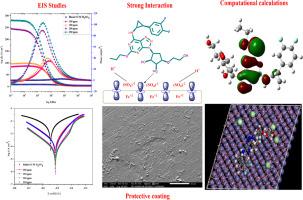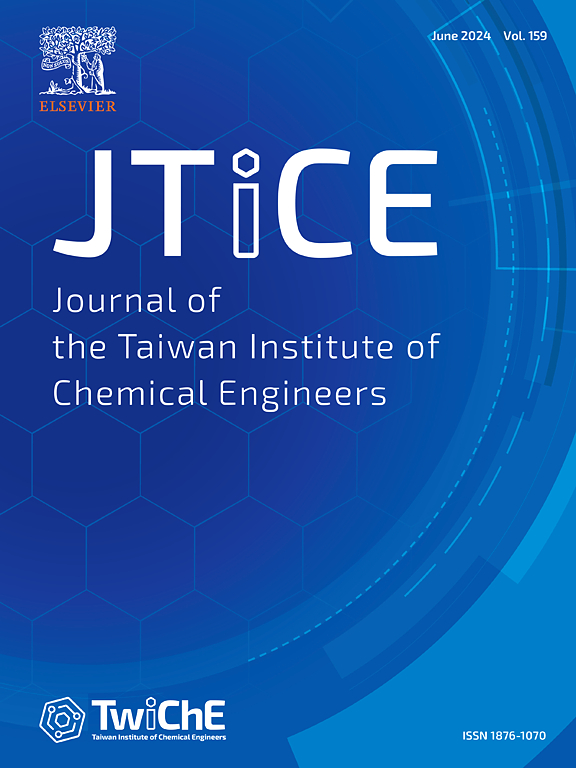Surface interaction of expired Brilcure (Ticagrelor) drug on soft-cast steel in 0.5 M H2SO4 medium: Corrosion protection, surface characterizations and computational studies
IF 5.5
3区 工程技术
Q1 ENGINEERING, CHEMICAL
Journal of the Taiwan Institute of Chemical Engineers
Pub Date : 2024-10-12
DOI:10.1016/j.jtice.2024.105791
引用次数: 0
Abstract
Background
Soft-cast steel (SCS) is extensively used in industry but is prone to corrosion in acidic solutions, necessitating effective protection methods. Corrosion inhibitors offer a rapid, easy, and economical solution. However, expired ticagrelor (Brilcure) poses environmental risks when discarded due to its active components. Therefore, this study explores the use of expired ticagrelor (TCGL) to prevent SCS corrosion in sulfuric acid, utilizing its active components, such as N and O atoms and conjugated bonds, as adsorption centers while being environmentally friendly.
Methods
The corrosion inhibition and adsorption properties of TCGL on SCS in 0.5 M H2SO4 were investigated using weight loss, potentiodynamic polarization (PDP), and electrochemical impedance spectroscopy (EIS) techniques. Surface characterization of SCS was performed using scanning electron microscopy with energy-dispersive X-ray spectroscopy (SEM-EDX), atomic force microscopy (AFM), and water contact angle (WCA) measurements. The adsorption behavior of TCGL followed the Langmuir isotherm model. Additionally, density functional theory (DFT) and molecular dynamics (MD) simulations were employed to elucidate the bonding interactions between TCGL and the metal surface.
Significant findings
Ticagrelor achieved 98.99 % inhibition efficiency at 250 ppm by adsorbing on the steel surface, forming a protective film. PDP studies showed decreased corrosion current density and a potential shift from -0.53 V to -0.49 V. SEM and AFM confirmed significant protection. DFT and MD simulations identified active sites and molecular mechanisms, highlighting Ticagrelor's potential as an effective, eco-friendly corrosion inhibitor for SCS.

过期 Brilcure(替卡格雷)药物在 0.5 M H2SO4 介质中与软铸钢的表面相互作用:腐蚀保护、表面特征和计算研究
背景软铸钢(SCS)广泛应用于工业领域,但在酸性溶液中容易腐蚀,因此需要有效的保护方法。缓蚀剂是一种快速、简便、经济的解决方案。然而,过期的替卡格雷(Brilcure)由于含有活性成分,在废弃时会对环境造成危害。因此,本研究利用过期替卡格雷(TCGL)的活性成分(如 N 原子、O 原子和共轭键)作为吸附中心,探索如何在环保的前提下使用过期替卡格雷防止硫酸中的 SCS 腐蚀。利用扫描电子显微镜与能量色散 X 射线光谱(SEM-EDX)、原子力显微镜(AFM)和水接触角(WCA)测量法对 SCS 进行了表面表征。TCGL 的吸附行为遵循 Langmuir 等温线模型。此外,还采用了密度泛函理论(DFT)和分子动力学(MD)模拟来阐明 TCGL 与金属表面之间的键合相互作用。PDP 研究表明,腐蚀电流密度降低,电位从 -0.53 V 下降到 -0.49 V。DFT 和 MD 模拟确定了活性位点和分子机制,凸显了 Ticagrelor 作为一种有效、环保的 SCS 缓蚀剂的潜力。
本文章由计算机程序翻译,如有差异,请以英文原文为准。
求助全文
约1分钟内获得全文
求助全文
来源期刊
CiteScore
9.10
自引率
14.00%
发文量
362
审稿时长
35 days
期刊介绍:
Journal of the Taiwan Institute of Chemical Engineers (formerly known as Journal of the Chinese Institute of Chemical Engineers) publishes original works, from fundamental principles to practical applications, in the broad field of chemical engineering with special focus on three aspects: Chemical and Biomolecular Science and Technology, Energy and Environmental Science and Technology, and Materials Science and Technology. Authors should choose for their manuscript an appropriate aspect section and a few related classifications when submitting to the journal online.

 求助内容:
求助内容: 应助结果提醒方式:
应助结果提醒方式:


